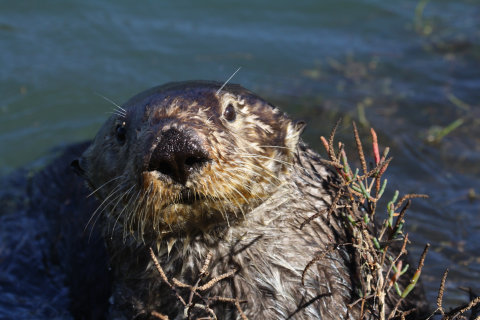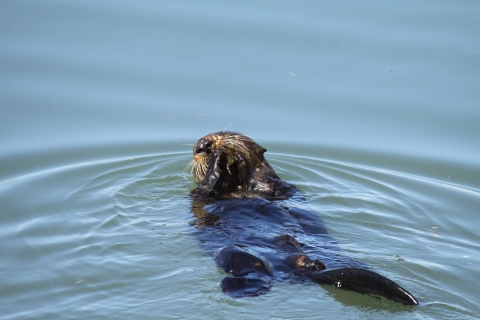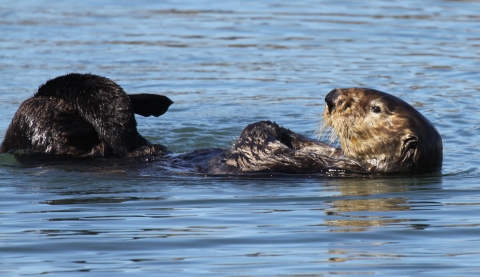In his famous essay, "Thinking like a Mountain," Aldo Leopold recounts an epiphany he experienced while watching the "fierce green fire" fade from the eyes of a dying wolf: "I thought that because fewer wolves meant more deer, that no wolves would mean hunter's paradise. But after seeing the green fire die, I sensed that neither the wolf nor the mountain agreed with such a view." The larger view that Leopold came to see, and that he tried to help others see, was that the predators his contemporaries vilified and systematically killed were an integral part of the ecosystem—important not only to the plants that the deer consumed but also, seemingly paradoxically, to the deer themselves. "Since then," Leopold writes,
I have lived to see state after state extirpate its wolves. I have watched the face of many a newly wolfless mountain, and seen the south-facing slopes wrinkle with a maze of new deer trails. I have seen every edible bush and seedling browsed, first to anaemic desuetude, and then to death. […] In the end the starved bones of the hoped-for deer herd, dead of its own too-much, bleach with the bones of the dead sage […]. I now suspect that just as a deer herd lives in mortal fear of its wolves, so does a mountain live in mortal fear of its deer.
Like wolves, sea otters were systematically eliminated from most of their native range. The maritime fur trade of the 18th and 19th centuries reduced the original sea otter population from a probable few hundred thousand animals, distributed along the North Pacific coast between northern Japan and central Baja California, Mexico, to less than a few thousand. Sea otters were believed to be extinct in the contiguous US by the time protections were enacted in the early 20th century—but as it happened a small group of sea otters had managed to survive in an isolated area off the rugged Big Sur coast of California. Numbering about 50 when they were first documented by a state biologist in 1915, these animals founded today's southern sea otter population, a distinct subspecies known as Enhydra lutris nereis.
The southern sea otter was listed as threatened under the Endangered Species Act (ESA) in 1977 and has since gradually reoccupied portions of its historic range: the central California coastline (through natural range expansion) and San Nicolas Island, off southern California (through translocation). The southern sea otter population index now registers approximately 3,000 animals—within sight of the threshold for delisting consideration. Yet the southern sea otter has far to go to reclaim its role as a "significant functioning element in the ecosystem of which [it is] a part," as mandated by the Marine Mammal Protection Act. The population size needed to attain that goal is probably at least 8,400 animals in California alone.
The vast majority of southern sea otters today inhabit the central California coastline, where sea otters in the longest-occupied areas near the middle of the range are at or near carrying capacity. The population's ability to expand into adjacent habitat to the north and south has been curtailed by accelerating rates of shark bite mortality in these areas. The small population of approximately 100 animals at San Nicolas Island is well below carrying capacity, growing, and apparently unaffected by shark-related mortality, but even counting the habitat at San Nicolas Island as occupied, the subspecies remains restricted to just a small portion—about 13 percent—of its historic range between Washington and central Baja California.
Whereas sea otters were killed during the fur trade for their lush pelts, not for competing with humans for prey, the effects of their removal from nearshore marine ecosystems were parallel to those following the elimination of wolves from terrestrial ecosystems. Lacking blubber, sea otters maintain warmth not only by meticulously grooming their dense fur, but by eating the equivalent of about 25 percent of their body mass each day. Calorie-rich sea urchins, herbivores that consume algae, are one of their preferred prey types. Just as deer and elk populations can proliferate and radically alter the landscape in the absence of wolves, hordes of hungry sea urchins, when released from sea otter predation, can trigger a switch to an "alternate stable state" in the nearshore environment—turning complex, multi-layered kelp forests that support myriad organisms into persistent "urchin barrens." Large numbers of hunger-stressed sea urchins carpet these expansive deforested areas, but few other species find habitat or food there. Although factors such as storms can also influence kelp abundance and distribution, where there are sea otters, kelp cover tends to increase. Because of their large-scale community effects—which are disproportionate to their abundance—sea otters, like wolves, are considered to be a "keystone" species.
During the long absence of sea otters from large stretches of the North American coastline, shellfish fisheries developed to exploit the unnaturally high abundance of bottom-dwelling invertebrates that were once the sea otter's prey. Abalone, especially, formed the basis of a lucrative commercial fishery and a booming sport fishery in California. When southern sea otters finally began to rebound from the deep injuries of the fur trade, they caused dramatic reductions in abalone densities along portions of the central California coast, leading to intense conflicts with abalone fishermen during the latter half of the 20th century. Sea otters were seen by some as alien invaders, even vermin, destroying a fisherman's paradise where abalone were sometimes piled several animals deep.
Abalone fisheries were closed throughout California in 1997, with the exception of a breath-hold sport fishery north of San Francisco. Whereas sea otters competed primarily with the central California red abalone fishery, all five species of commercially exploited abalone had declined to alarmingly low numbers throughout the state by the time the fisheries were closed. Two species were subsequently listed as endangered under the ESA—white abalone due to overfishing, and black abalone due to disease and overfishing. Lest sea otters be blamed for these declines, it is important to note that the post-fur-trade range of southern sea otters overlaps with only a portion of the range of black abalone and is almost mutually exclusive with the range of white abalone. Whereas a commercial abalone fishery cannot likely coexist with sea otters, it is untrue that the abalone themselves cannot coexist with sea otters. In fact, paradoxical as it may seem, sea otters not only benefit the larger ecosystem, but they also indirectly benefit their prey.
The high densities of black abalone in the mid-1980s at the Channel Islands—from which sea otters were essentially absent—are thought to have exacerbated the spread of withering syndrome because of the close contact between large numbers of animals. Warm waters also increased the disease's devastation, and as a result black abalone were nearly eliminated from southern California. For reasons that remain unclear, one of the only healthy, increasing populations of black abalone remaining in southern California by the time of the species' listing occurred in the only location that also had sea otters: San Nicolas Island. Within the cooler portions of the black abalone's range that were never affected by withering syndrome, and which have an abundance of deep crevice habitat, sea otter density is positively associated with increased black abalone density. Possible explanations for this sea otter effect are the shift in black abalone to habitat providing greater refuge, which can protect them from illegal human harvest, or increased abundance of drift kelp, the primary food of abalone. From an evolutionary perspective, the abalone of the eastern North Pacific Ocean may actually owe their species diversity and large body size to sea otters. According to this hypothesis, by forcing abalone into deep crevice habitat to escape predation, where they subsist solely on drift kelp, sea otters protected the kelps from herbivory, reducing their need to evolve chemical defenses, thereby increasing the quality of the drift kelp for the herbivores.
Because the science of ecology developed after sea otters were eliminated from much of their native habitat, some of the ecological effects of this apex predator are still unknown. A trophic cascade even more complex than the sea otter-sea urchin-kelp relationship was recently discovered in the eelgrass beds of the Elkhorn Slough estuary, where sea otter densities are the highest in the California range. In this tidal wetland, human-caused nitrogenous pollution causes algal epiphytes to grow on the blades of eelgrass, blocking sunlight and ultimately killing the plants. Sea slugs graze these algal epiphytes, but when crabs are present, they prey so heavily on the sea slugs that the slugs cannot keep ahead of the algal growth. By consuming large numbers of crabs, sea otters protect the sea slugs, allowing them to become not only more numerous but also larger and more efficient grazers—and in doing so, they protect the eelgrass, which provides habitat for a multitude of other species.
New and surprising effects of sea otters routinely come to light. For instance, in addition to consuming native crabs in Elkhorn Slough, sea otters also consume exotic green crabs, helping to buffer the estuary against invasion. And by promoting the growth of kelp and eelgrass, sea otters buffer the shoreline against erosion and help to sequester the atmospheric carbon that is causing climate change climate change
Climate change includes both global warming driven by human-induced emissions of greenhouse gases and the resulting large-scale shifts in weather patterns. Though there have been previous periods of climatic change, since the mid-20th century humans have had an unprecedented impact on Earth's climate system and caused change on a global scale.
Learn more about climate change .
Recovery of a species requires more than rescuing it from the brink of extinction—recovery is also about the restoration of ecological relationships. We live in an age of grave environmental challenges, but in many ways it is also an age of restoration. Sea otters are arguably the most important factor in the recovery of their native ecosystems. Through them, we may come to understand what it means to think like an ocean.
Additional Reading:
Estes, J.A. and J.F. Palmisano. 1974. Sea otters: their role in structuring nearshore marine communities. Science 185:1058-60.
Estes, J.A. et al. 2011. Trophic downgrading of planet earth. Science 333:301–306.
Hughes, B.B., R. Eby, E. Van Dyke, M.T. Tinker, C.I. Marks, K.S. Johnson, and K. Wasson. 2013. Recovery of a top predator mediates negative eutrophic effects on seagrass. Proceedings of the National Academy of Sciences 110:15313-15318.
Estes, J.A., D.R. Lindberg, and C. Wray. 2005. Evolution of large body size in abalones (Haliotis): patterns and implications. Paleobiology 31(4): 591-606.






